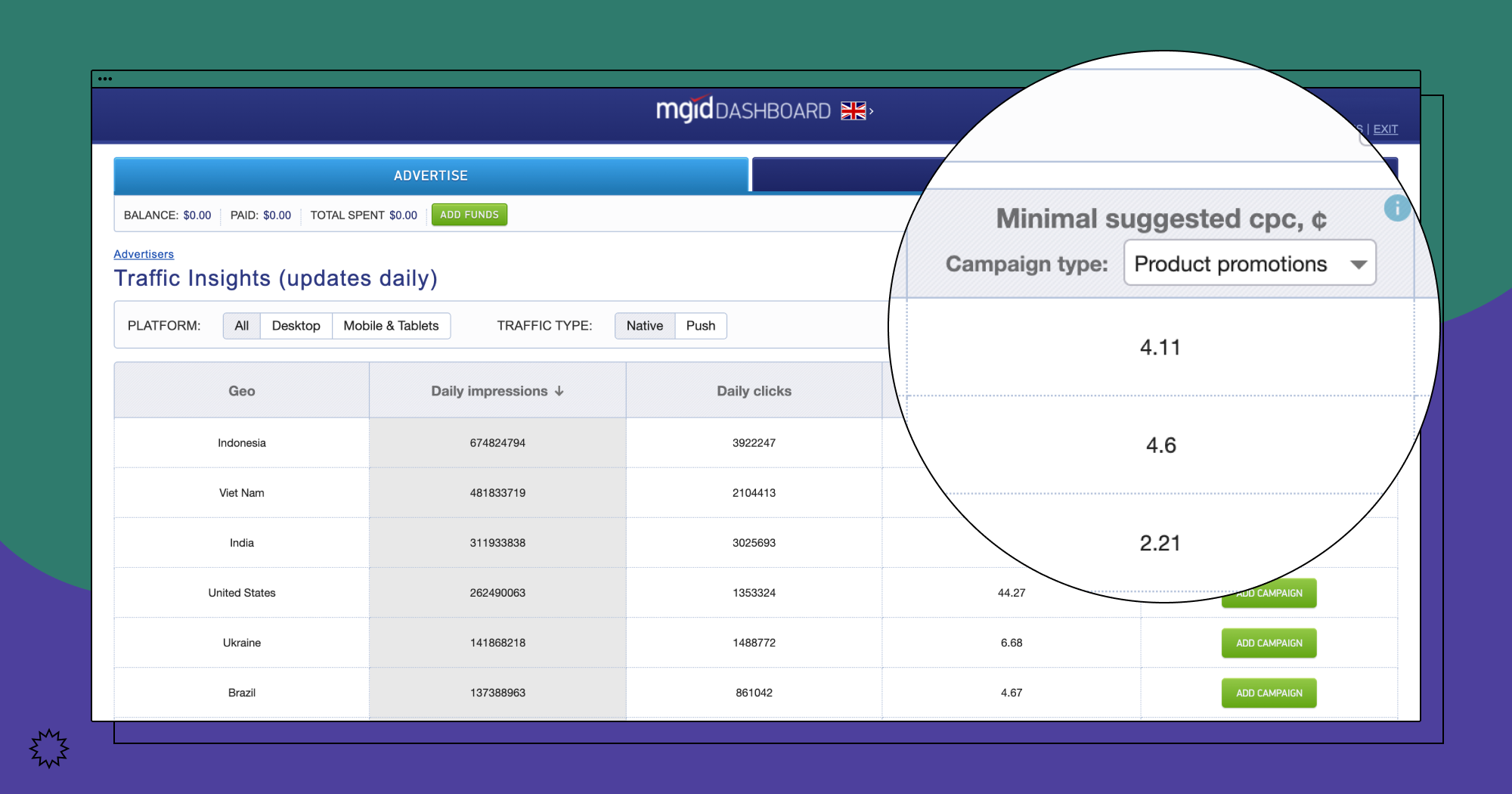Updated: August 30, 2024
Editor’s note: This article has been contributed by Olha Sukhinina, MGID's Head of Account Management whose #1 KPI is to ensure advertisers meet their business objectives on our global ad platform.
Let’s say you’ve heard about all the benefits of native advertising. Now, you want to get a better idea of how much it costs today in 2024. If only it were that simple! The price tag for each ad campaign depends on so many variables that I could probably write a standalone book dealing with this subject.
But I’m not a fan of writing long-form content.
What I do like is seeing businesses succeed with native ads. And — since I get this question a lot — I feel like the internet deserves at least one comprehensive article explaining native advertising costs, what affects these costs and how to not overpay for your campaign launches.
Let’s do it.
How Much Does Native Advertising Cost?

The harsh truth is ad platforms tend to NOT share costs or pricing tiers on their websites.
The reason is simple: every ad campaign is unique and every business sets different KPIs for their end goals. One business may want to raise brand awareness, while another might want to achieve quick performance results and conversions. But generally speaking, you get what you pay for.
But generally speaking, you get what you pay for.
Native advertising is priced by CPM or CPC. If you choose the Cost per Mille (CPM) model, you pay a certain price for 1000 ad impressions. If you choose the Cost per Click (CPC) model, you pay a publisher every time an ad is clicked. Therefore, you can choose how you pay for an ad: either when a user sees your advertisement or when they click on it.
A native advertising campaign costs anywhere between $500 to $1,000,000. The cost is defined by many variables: publishers’ inventory (and their domain authority), target audience and the level of competition for traffic in the desired geo.
I will dive deeper into what makes up the cost of native advertising in more detail. But for now, I want you to understand that the cost of native advertising is something you have full control over. Native advertising costs depend on your business objectives and what you’re trying to achieve.
Pro Tip #1: If you decide to give it a go at MGID, we provide a free Account Manager. Once you share your business goals with them, they will suggest a cost estimate and the ideal entry point ($) to start with native ads.
What Factors Affect Native Advertising Costs?

Understanding the key components of native advertising costs is no brainer. The real hurdle you have to cross is understanding how much funds to allocate to your ad campaign while not overpaying and hitting the maximum ROI (rest assured I’ll get into that later).
For the moment, let’s try to get a balanced view of what makes up the cost of native advertising:
Business Niche
When you’re first starting out with native advertising, you should understand the connection between your business and the cost of native advertising. The more niche your product offering is, the more money it takes to advertise.
Let’s say you’re advertising luxury apartments. Some people may think there are many consumers in the world looking to buy expensive mansions in Manhattan — in actuality, there are not. Far from it. In fact, real estate is a very niche market with a really niche audience. You’d then have to narrow down your targeting to extreme lows to find these people.
Or you could advertise window blinds, which opens the floodgates to a much wider audience and targeting possibilities thereof. Mass market products will always find a way to reach their end consumer, making advertiser’s job a breeze.
Pro Tip #2: Targeting consumers with mass market products is usually easier and cheaper for advertisers.
GEO
The country and location might be the second major factor that affects the cost of native advertising campaigns. For instance, a native ad campaign launched in one country might be twenty times cheaper than in another one.
Why is that? Because competition is different for every country. There're no two identical markets. There're no two identical numbers of estimated campaign reach. One country might be smaller but have fierce competition in the automotive industry, while another could be more populated and offer more ad impressions.

Pro tip #3: If you end up launching your native ad campaign on our global ad platform, you get access to the AI-powered Traffic Insights tool. This tool shows potential traffic, clicks, campaign costs and the best-performing GEOs based on your targeting.
Seasonality
Native advertising costs are going to fluctuate rather drastically depending on the season. If you decide to advertise during holidays, the ad costs are going to naturally skyrocket for all product types. From winter celebrations to summer fiestas and everything in between, there’s a spike in ad costs for every time of the year.

Pro tip #4: If you go to your personal MGID dashboard, the Reach Meter shows your potential ad campaign reach and the level of competition at any given time of the year, so you can track average prices for each season.
Ad Relevance
But don’t mistake high CTRs for good campaign results. I’ve seen so many advertisers design clickbait-y ad creatives with the mere intention of grabbing people’s attention and generating clicks. Following this approach, I have no doubt that you will get a very high CTR. But what good does it make if you also get zero-to-nothing conversions?
The point we want to reinforce here is that your ad assets (creative, pre-landing, offer) should all be relevant to your audience only. Ask yourself the next time you see a high CTR, “Is it my target audience clicking on the ad or people in general?”
How to Save on Native Advertising Costs?

Perhaps we shouldn’t admit this, but native advertising costs can bite at times. Unlike Facebook ads where you can (sometimes) achieve all the quick wins, native advertising demands more budget for experimentation and optimization. Yet, these efforts pay off with respectively higher profit margins.
If you don’t run experiments with native ads, then you might achieve a certain number of conversions but it would be far from its potential. However, if you allocate a sufficient test budget and optimize your campaign the right way, then you would likely open doors to previously untapped revenue streams.
If you were to ask me for advice on how to save native advertising costs, I’d say the following:
Choose 30% higher CPC than suggested. When you’re just starting out your ad campaign, the ad platform will suggest you the minimal cost per click. We recommend choosing at least 30% higher CPC than suggested in order to test more publishers and find the most efficient traffic sources for your campaign. Otherwise, you risk wasting your ad budget on irrelevant audiences.
Compare CR to CTR. While CTR is an important metric, try not to focus on it too much. Instead, we recommend advertisers to pay attention to the CR/CTR ratio. The number will show the relevance of your ads to your target audience. The lower the ratio, the more you’re overpaying for your native ad campaign. With the CPC model, keep in mind that you’re paying for each click. So, it’s absolutely important to make each click count towards conversions as opposed to the bare CTR metric.
Limit your budget to 3x CPA. You should make your ad budget at least three times higher than your overall CPA. For example, if your expected CPA amounts to $90, then you should set a limit to your budget of $180 or more. Doing so ensures you collect enough data to make informed decisions about your next move: bid down on ad creatives that don’t work and double-down on those that perform well.
Set up tracking software. Before launching your native ad campaign, take time to install tracking software. For example, people advertising on our platform install either the MGID pixel or go with postback tracking. Any tracking method is fine as long as you track conversions and user behavior at every stage of the marketing funnel.
Pro tip #5: The MGID dashboard allows advertisers to configure up to three goal completions, so leverage that functionality to collect as much user data as possible.
- Retarget your target audience. Once you finish testing ad creatives and have gathered enough tracking data, you can leverage that information to retarget your audience with a new message or set of ad creatives. The general trend we see more often than not is people are more likely to convert with retargeting campaigns. The point of retargeting is that you are able to target your audience with a more personalized message using collected data from the previous campaign. We see this work exceptionally well for eCommerce companies and brands.
Summary: Why Native Advertising Matters in 2024?
Much like the overall digital ad industry, native advertising keeps finding its place in today’s digital ad spend. While the pandemic and recession have left a mark on today’s economy, businesses are still taking stock of new advertising channels and are continuing to add native advertising to their media mix.
With native advertising, you will be able to extend your audience reach: tell your brand’s story, promote new product offers and last but not least, be closer to your performance goals. Native advertising costs have been solidified firmly into the ad budget of many businesses with its unique ability to blend in with the web content and overcome the banner ad blindness of today’s digital consumer.
Feel free to preview native ads and get a feel for how ads appear on MGID. Our global platform allows advertisers to test drive several ad formats before launching a new campaign.
Hope this article comes in handy!





